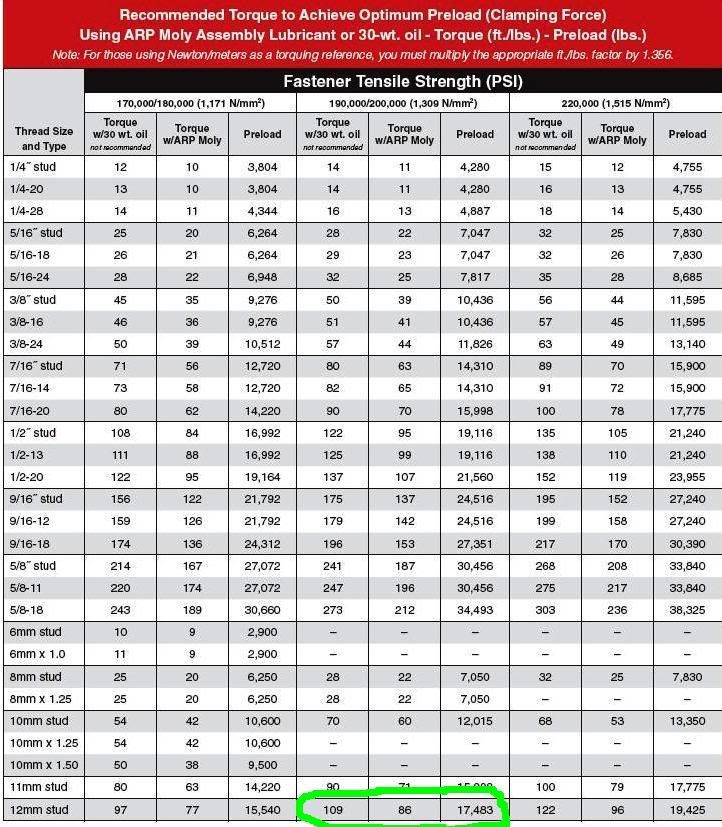I hate to disagree with you shaeff because usually you are spot on. And it is true that many people run with 75 ft/lbs with out a problem. However I would like to point out some things.
1. The 75 ft/lbs recommendation was made for Toyota hardware.
2. ARP recommends 86ft/lbs for a reason, to achieve proper preload. Head bolts are similar to springs because of the metal they are made of. Just as you need to stretch a spring to a certain limit to achieve the correct clamping pressure. You need to stretch the head bolt to a certain limit, other wise it may stretch a little more under pressure from things like thermal expansion of the aluminum in the head and combustion pressures at higher boost levels. You need to have the correct preload on the head bolt so it doesn’t stretch more than expected.
3. If he only dialed in 75ft/lbs of torque using 30 wt. oil ( like most old school engine builders do), there is almost a 20 ft/lbs difference in torque reading between the oil and moly lube. This means a 75 ft/lbs reading with 30 wt. would be a 55 ft/lbs reading on moly lube. And as we all have had drilled into our heads 55 ft/lbs is bad and will result in failed head gaskets. This is the reason I would like to clarify what he used for lube.
However on the other side of the coin siman’s recommendation of cranking in another 15-25ft/lbs of torque isn’t the best idea either.
Taken from ARP’s website : http://www.arp-bolts.com/Catalog/Catalog.Images/2005ARPCatalog.pdf
Over torquing a bolt is also a bad idea. Over tightening a bolt may not have an immediate affect however after repeated trips to, or near it’s yield limit because of the different expansion rate of the aluminum head the bolt may lose its ductility, the ability to stretch and contract while maintaining the correct clamping force.( the spring when pulled to far out one to many times will ware out and lose it strength.)
It’s a good idea to follow ARP’s recommended torque value, they spent a lot of money to figure out just where the right point is. Over tightening a bolt does nothing but make you feel better in the back of your mind, and in the end may be detrimental to your motor.
1. The 75 ft/lbs recommendation was made for Toyota hardware.
2. ARP recommends 86ft/lbs for a reason, to achieve proper preload. Head bolts are similar to springs because of the metal they are made of. Just as you need to stretch a spring to a certain limit to achieve the correct clamping pressure. You need to stretch the head bolt to a certain limit, other wise it may stretch a little more under pressure from things like thermal expansion of the aluminum in the head and combustion pressures at higher boost levels. You need to have the correct preload on the head bolt so it doesn’t stretch more than expected.
3. If he only dialed in 75ft/lbs of torque using 30 wt. oil ( like most old school engine builders do), there is almost a 20 ft/lbs difference in torque reading between the oil and moly lube. This means a 75 ft/lbs reading with 30 wt. would be a 55 ft/lbs reading on moly lube. And as we all have had drilled into our heads 55 ft/lbs is bad and will result in failed head gaskets. This is the reason I would like to clarify what he used for lube.
However on the other side of the coin siman’s recommendation of cranking in another 15-25ft/lbs of torque isn’t the best idea either.
Taken from ARP’s website : http://www.arp-bolts.com/Catalog/Catalog.Images/2005ARPCatalog.pdf
ARP said:It is important to note that in order for a fastener to function properly it must be “stretched” a specific amount. The material’s ability to “rebound” like a spring is what provides the clamping force. You should know that different materials react differently to these conditions, and ARP engineers have designed each fastener to operate within specific ranges.
On the other hand, if a fastener is over torqued and becomes stretched too much – you have exceeded the yield strength and it’s ruined. If the fastener is longer than manufactured – even if it is only .001,˝ it is in a partially failed condition. Therefore, ARP has engineered its fasteners with the ductility to stretch a given amount and rebound for proper clamping.
Heat, primarily in aluminum, is another problem area. Because the thermal expansion rate of aluminum is far greater than that of steel it is possible to stretch a fastener beyond yield as the aluminum expands under heat. An effective way of counteracting material expansion is through producing a more flexible bolt.
Over torquing a bolt is also a bad idea. Over tightening a bolt may not have an immediate affect however after repeated trips to, or near it’s yield limit because of the different expansion rate of the aluminum head the bolt may lose its ductility, the ability to stretch and contract while maintaining the correct clamping force.( the spring when pulled to far out one to many times will ware out and lose it strength.)
It’s a good idea to follow ARP’s recommended torque value, they spent a lot of money to figure out just where the right point is. Over tightening a bolt does nothing but make you feel better in the back of your mind, and in the end may be detrimental to your motor.


